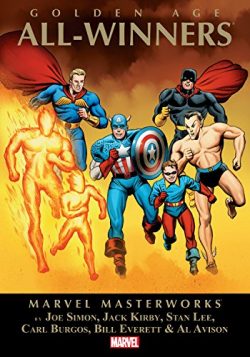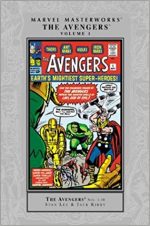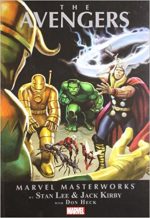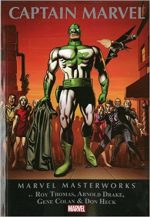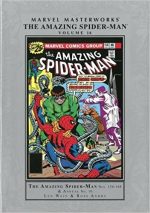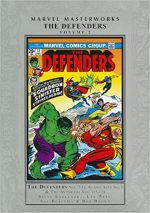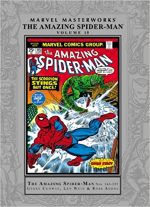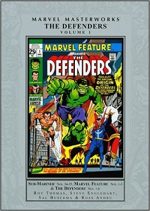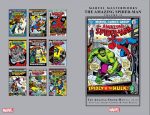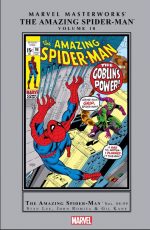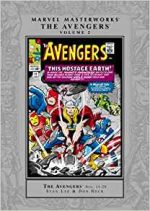
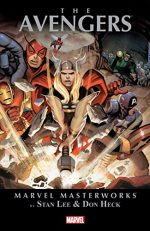
By Stan Lee, Don Heck, Dick Ayers & various (Marvel)
ISBN: 978-0-7851-3202-8 (HC)Â Â Â Â Â Â Â Â Â Â Â Â Â Â Â Â Â Â Â 978-0785137085 (TPB)
Win’s Christmas Gift Recommendation: Immortal masterpieces to savour forever… 9/10
Whenever Jack Kirby left a title he’d co-created it took a little while to settle into a new rhythm, and none more so than the collectivised costumed crusaders called the Avengers. Although writer Stan Lee and the fabulously utilitarian Don Heck were perfectly capable of producing cracking comics entertainments, they never had The King’s unceasing sense of panoramic scope and vast scale which constantly searched for bigger, bolder blasts of excitement. After Kirby, the tales starring Thor, Iron Man, Giant Man, The Wasp and scene-stealing newcomer Captain America concentrated on frail human beings in costumes, not wild modern gods bestriding and shaking the Earth…
Following another Stan Lee introduction, the wonderment herein contained (covering issues #11-20, December 1964 – September 1965 and available in Hard Cover, Trade Paperback and eBook editions) begins with ‘The Mighty Avengers Meet Spider-Man!’; a clever and classy cross-fertilising tale inked by Chic Stone and featuring the return of time-bending tyrant Kang the Conqueror. Here, he attempts to destroy the team by insinuating a robotic duplicate of the outcast hero within their serried ranks. It’s accompanied by a Marvel Master Work Pin-up of ‘Kang!’ and followed by a cracking end-of-the-world thriller with Fantastic Four guest-villains Mole Man and the Red Ghost.
This was another Marvel innovation, as – according to established funnybook rules – bad guys stuck to their own nemeses and didn’t clash outside their own backyards….
‘This Hostage Earth!‘ (inked by Dick Ayers) is a welcome return to grand adventure with lesser lights Giant-Man and the Wasp taking rare lead roles, but is trumped by a rousing gangster thriller of a sort seldom seen outside the pages of Spider-Man or Daredevil, which introduced Marvel universe Mafia analogue The Maggia and another major menace in #13’s ‘The Castle of Count Nefaria!’
After failing in his scheme to frame the Avengers, Nefaria was crushed, but the caper ended on a tragic cliffhanger as Janet Van Dyne is left gunshot and dying, leading to a peak in melodramatic tension in #14 (scripted by Paul Laiken & Larry Lieber over Stan’s plot) as the traumatised team scour the globe for the only surgeon who can save her.
‘Even Avengers Can Die!’ – although of course she didn’t – resolves into an epic alien invader tale with overtones of This Island Earth with Kirby stepping in to lay out the saga for Heck & Stone to illustrate, which only whets the appetite for a classic climactic confrontation as the costumed champions finally deal with the Masters of Evil and Captain America finally avenges the death of his dead partner Bucky.
‘Now, by My Hand, Shall Die a Villain!’ in #15 (again laid-out by Kirby, pencilled by Heck but now inked by Mike Esposito) features the final, fatal confrontation between Captain America and Baron Zemo in the heart of the Amazon jungle, whilst the other Avengers and Zemo’s cohort of masked menaces clash once more on the streets of New York City…
The battle ends in concluding episode ‘The Old Order Changeth!’ (again visually broken down by Kirby before being finished by Ayers) which presaged a dramatic change in concept for the series; presumably because, as Lee increasingly wrote to the company’s unique strengths – tight continuity and strongly individualistic characterisation – he found juggling individual stars in their own titles as well as a combined team episode every month was just incompatible if not impossible.
As Cap and teen sidekick Rick Jones fight their way back to civilisation, the Avengers set-up changes completely with big name stars retiring only to be replaced by three erstwhile villains: Hawkeye, Quicksilver and the Scarlet Witch.
Eventually, led by perennial old soldier Captain America, this relatively powerless group with no outside titles to divide the attention (the Sentinel of Liberty did have a regular feature in Tales of Suspense but it was at that time recounting adventures set during the hero’s WWII career), evolved into another squabbling family of flawed, self-examining neurotics, enduring extended sub-plots and constant action as valiant underdogs; a formula readers of the time could not get enough of and which still works superbly well today…
Acting on advice from the departing Iron Man, the neophytes seek to recruit the Hulk to add raw power to the team, only to be sidetracked by the malevolent Mole Man in #17’s ‘Four Against the Minotaur!’ (Lee, Heck & Ayers), after which they then fall foul of a dastardly “commie†plot ‘When the Commissar Commands!’ – necessitating a quick trip to a thinly disguised Viet Nam analogue dubbed Sin-Cong and a battle against a bombastic android…
This brace of relatively run-of-the-mill tales is followed by an ever-improving run of mini-masterpieces starting with a 2-part gem providing an origin for Hawkeye and introducing a rogue-ish hero/villain to close this sturdy, full-colour compendium.
‘The Coming of the Swordsman!’ premiers a dissolute and disreputable swashbuckler – with just a hint of deeply-buried nobility – who attempts to force his way onto the highly respectable team. His rejection lead to him becoming an unwilling pawn of a far greater menace after being kidnapped by A-list world despot the Mandarin.
The conclusion comes in the superb ‘Vengeance is Ours!’ – inked by the one-&-only Wally Wood – wherein the constantly-bickering Avengers finally pull together as a supernaturally efficient, all-conquering super-team.
Augmented by original art, production-stage corrections photostats plus the usual round of Biographies, these immortal epics are tales that defined the Marvel experience and a joy no fan should deny themselves or their kids.
© 1963, 1964, 2017 Marvel Characters, Inc. All rights reserved.

